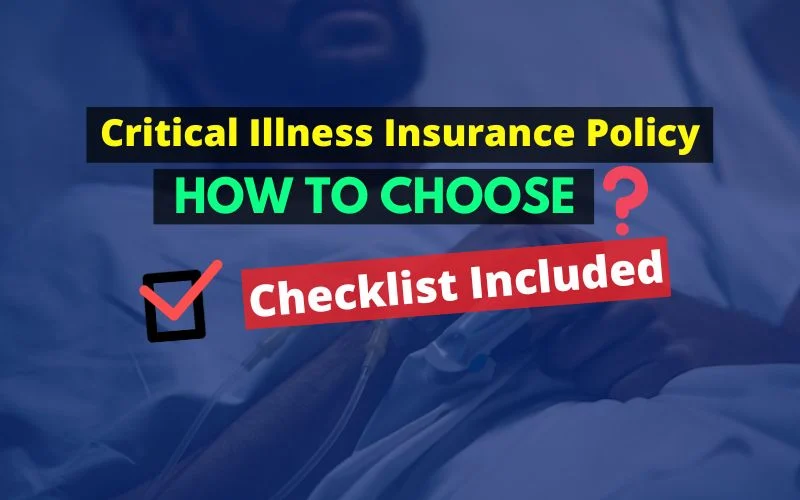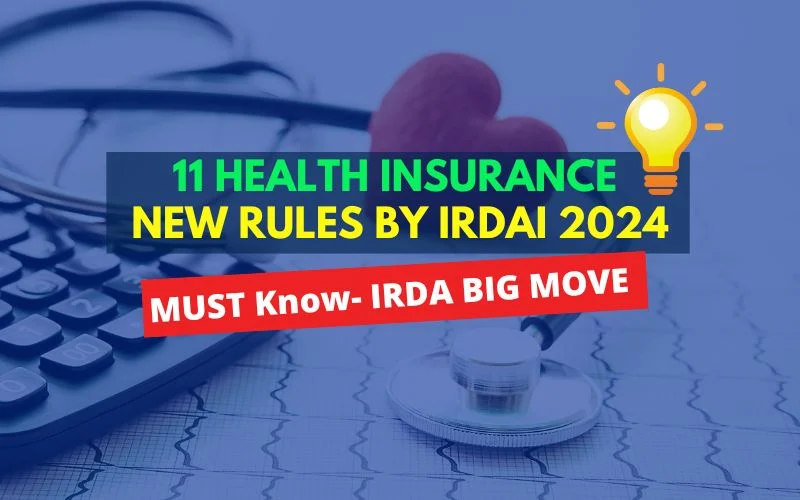Critical illness is no longer uncommon. Buying a critical illness cover is essential to protect an individual’s family from medical uncertainty. In this article, we will understand critical illness in-depth, its benefits, and learn from critical illness insurance checklist to select the right insurance policy for critical illness.

What is Critical Illness Policy?
Critical illness is a medical illness that is often life-threatening and significantly impacts a person’s health. With developments in the medical field, we have possible treatments that can save an individual’s life if diagnosed early. However, the treatments are not done at one time but in a process that can take several months, which is very expensive.
Critical Illness Insurance Plan vs Health Insurance Plan
The purposes of both the policies are entirely different. A critical illness insurance plan covers only life-threatening diseases in the policy, whereas a Health insurance plan covers illnesses that usually need hospitalization.
| Parameters | Critical Illness Insurance Plan | Health Insurance Plan |
|---|---|---|
| Meaning | It covers life-threatening diseases like cancer, Complete Heart Block, etc. | It provides comprehensive health insurance coverage, including hospitalization expenses, daycare, etc. |
| Benefits | A critical Illness diagnosis is enough to get a lump-sum payment; hospitalization is not required. | The insured can get reimbursement for incurred hospitalization expenses by submitting bills. They can also avail themselves of the cashless facility at network hospitals. |
| Coverage | It offers coverage for up to 36 critical illnesses. | It includes pre-hospitalization expenses and post-hospitalization expenses. |
| Waiting Period | There is a waiting period that depends on the severity of the illness. | There is a waiting period of 30 days, and for pre-existing diseases, two years or more varies from company to company. |
Features of Critical Illness Insurance Plans
Critical Illness Insurance Plans offer specific features designed to provide financial protection in the event of a severe health condition. While the details may vary among insurance providers, common features of these plans include:
Coverage for Defined Critical Illnesses: Critical Illness Insurance typically covers a specified list of severe health conditions, such as cancer, heart attack, stroke, organ transplantation, and other major illnesses. The policy outlines the specific illnesses for which benefits are payable.
Lump-Sum Payout: The insurance plan pays a lump sum benefit when the policyholder is diagnosed with a covered critical illness. This benefit is a one-time payment and is not dependent on the expenses incurred in the treatment.
No Requirement for Medical Bills: Unlike some health insurance plans, critical illness insurance does not necessarily require the policyholder to provide medical bills or receipts to receive the benefit. The lump sum is paid upon diagnosing a covered illness by submitting the required documents.
Survival Condition: Critical Illness Insurance plans settle claims only if the policyholder survives a specified waiting period after diagnosing a critical illness (usually 30 days).
Waiting Periods: Critical illness policies may have waiting periods before coverage becomes effective. During this waiting period, typically 30 days, the policyholder may not be eligible for benefits. Waiting periods are in place to prevent individuals from purchasing coverage after a diagnosis.
Illnesses Covered in Insurance Policy For Critical Illness
Cancer: This includes various forms of cancer, such as lung cancer, breast cancer, and more. The uncontrolled growth and spread of abnormal cells characterize cancer.
Heart Attack: A heart attack occurs when blood flow to a portion of the heart muscle is blocked, usually due to a clot in one of the coronary arteries. It can lead to heart muscle damage or even death if not treated promptly.
Stroke: A stroke happens when blood flow to the brain is disrupted due to a blood clot or bleeding in the brain. Strokes can result in brain damage, paralysis, or cognitive impairment.
Organ Failure: Critical illnesses can also involve the failure of vital organs such as the kidneys, liver, or lungs. Organ failure may require organ transplantation or ongoing medical treatment.
Neurological Diseases: Conditions like multiple sclerosis, major head trauma, and Parkinson’s disease are considered critical illnesses.
The Need for a Critical Illness Policy
Critical illness is no longer uncommon due to changes in lifestyle and eating habits. Critical illness coverage is necessary for insurance and financial planning to protect families and safeguard hard-earned savings.
Who Should Buy Critical Illness Insurance Policy?
Critical Illness Insurance can be a valuable financial tool for individuals. I believe every individual should have it as a part of health protection.
Breadwinners of the family: Individuals responsible for their family’s financial well-being must consider critical illness insurance to ensure their families are financially protected if they cannot work due to a severe illness.
Individuals with an inadequate emergency fund: For individuals not having substantial emergency savings to cover potential medical expenses, a critical illness insurance policy can provide a lump sum benefit that can help offset the financial impact of a severe health condition.
Individuals with a Family History of Critical Illness: Individuals with a family history of specific critical illnesses may consider purchasing; however, getting cover in such conditions changes are low, but there is no harm in trying.
People Concerned about Lifestyle Risks: Individuals engaged in high-risk activities like having a history of unhealthy habits, engaged with high-stress occupations, etc
What is Term Insurance with Critical Illness Insurance Cover?
| Particulars | Term Insurance | Critical Illness Insurance |
|---|---|---|
| Insurance Type | Life insurance | Medical insurance |
| Benefit Upon | Death | Survival |
| Tax Benefit under section | 80C | 80D |
| Maximum Tax Benefit | 1.5 Lakhs | 25,000 (Non-Senior Citizen) 50,000 (Senior Citizen) |
Checklist to Keep in Mind While Opting for a Critical Insurance Policy
Covered Critical Illnesses: Understand the list of critical illnesses covered by the policy. Different insurers may have variations in the types of illnesses included. Ensure that the policy covers the critical illnesses that concern you or are relevant to your family’s medical history.
Survival Condition: Critical Illness Insurance plans settle claims only if the policyholder survives a specified waiting period after diagnosing a critical illness (commonly 30 days).
Waiting Periods: Critical illness policies may have waiting periods before coverage becomes effective. During this waiting period, typically 30 days, the policyholder may not be eligible for benefits. Waiting periods are in place to prevent individuals from purchasing coverage after a diagnosis.
Exclusions and Limitations: Carefully review the policy’s exclusions and limitations. Understand the conditions or situations under which the policy will not provide coverage. A few common exclusions include pre-existing conditions, self-inflicted injuries, and certain risky activities.
Policy Renewability: Check whether the policy is renewable and for how long. The option to renew the policy ensures continued coverage, as critical illness risks may increase with age. Understand any limitations or changes in premium rates upon renewal.
Benefit Payout Structure: Understand how the benefit is paid out. Critical illness insurance typically provides a lump sum benefit, but some policies may offer a specific percentage of the sum assured to minor illnesses or capped particular diseases.
Eligibility Criteria for Purchasing Critical Illness Plan
Age: Insurers often have minimum and maximum age requirements for individuals seeking to purchase a Critical Illness Plan. The age limits vary, so checking with the specific insurance provider is essential.
Health Status: The applicant’s health condition is a crucial factor. Insurance companies may require individuals to undergo a medical examination or answer a detailed health questionnaire to assess their health status. Some policies may have stricter health requirements than others.
Medical History: Insurers may inquire about the applicant’s medical history, including pre-existing conditions. Some critical illness insurance policies exclude coverage for pre-existing conditions, at least for a certain period.
Lifestyle and Habits: Certain lifestyle factors, such as smoking or engaging in high-risk activities, may impact eligibility and premium rates. Insurers often assess lifestyle habits that could contribute to the risk of developing critical illnesses.
Occupation: The nature of the applicant’s occupation may influence eligibility and premium rates. Individuals in high-risk or hazardous occupations may face different criteria or pricing structures.
How to File a Claim for Critical Illness Policy?
Usually, it is a three steps process:
Step 1: Contact the Insurance Provider – Notify the insurance provider immediately after being diagnosed with a covered critical illness.
Step 2: Submit the Claim – Submit the completed claim forms and supporting documentation to the insurance provider through the specified channels, often through email, an online portal, or by visiting the branch. Keep a copy of all documents for your records.
Step 3: Claim Approval or Denial – Once the assessment is complete, the insurer will communicate the decision regarding the claim. If the claim is approved, the insurer will outline the payout details. If the claim is denied, the insurer will provide reasons for the denial.
What is a Critical Illness Rider?
An insurance rider is a provision to add an additional feature that can be added to a basic insurance policy; the rider helps add extra benefits beyond what is included in the standard policy.
The two popular ride options available with life insurance are critical illness rider and accidental death benefit rider.
Why Should You NOT Buy a Critical Illness Rider?
The only benefit of adding Critical Illness as a rider to the life insurance policy is that the premium gets fixed until the policy term. In contrast, a standalone critical illness policy premium increases every five years (at age 20, 25, 30, and so on), just like a health insurance policy. However, I suggest buying a standalone Critical Illness Insurance due to the following:
- The term insurance rider critical illness has limited illness coverage. However, standalone critical illness covers several critical illnesses.
- The need for term insurance is until you earn and your family financially depends on you. Your term insurance needs to get over if you have enough assets to cover your financial goals. Usually, post-retirement, you don’t need term insurance. However, if you club term and critical illness insurance, continuing the policy for maximum tenure becomes compulsory as you cannot separate the life and critical illness insurance.
- When you club the life and critical illness insurance and unfortunately claim for the critical illness, your policy tenure gets reduced by the claimed amount. Example: Mr. X bought a basic sum assured of 1,00,00,000 with a critical illness rider and happened to claim Rs. 20 lakhs for critical illness. Mr. X’s life insurance sum assured will be reduced by Rs. 20 lakhs, and now his life is covered with Rs. 80 lakhs only. Hence, keeping the cover separate and planning for a secured financial future is better.
Exclusions of a Critical Illness Insurance Policy
The exclusion of a Critical Illness Insurance Policy outline specific situations or conditions under which the insurance coverage may not apply. While the exact exclusions can vary between insurance providers and policies, here are common elements that are typically excluded from coverage:
Pre-Existing Conditions: Critical illness insurance policies often exclude coverage for conditions before the policy was issued. Pre-existing conditions are typically not covered, and a waiting period is usually specified in the policy schedule at the commencement of the period of cover.
Non-Disclosure or Misrepresentation: The insurance company may exclude coverage for related conditions if the policyholder fails to disclose relevant medical information or provides inaccurate information during the application process.
Natural Peril: Any natural peril (including but not limited to storms, cyclones, avalanches, earthquakes, volcanic eruptions, hurricanes, or any other kind of natural hazard).
Criminal or Illegal Activities: Injuries or illnesses resulting from criminal or illegal activities may be excluded from coverage. This exclusion discourages fraudulent claims arising from unlawful actions.
Self-Inflicted Injuries: Intentional self-inflicted injuries, for example, attempted suicide, are generally excluded from coverage. This exclusion is in place to prevent individuals from taking advantage of the insurance policy under harmful circumstances.
War and Terrorism: Injuries or illnesses caused by acts of war, terrorism, or participation in military activities may be excluded. These exclusions are often applied to mitigate the insurer’s risk in situations of widespread conflict.
Injuries from Hazardous Activities: Participation in hazardous activities, such as extreme sports or high-risk hobbies, may lead to exclusions. Insurers may consider these activities as increasing the likelihood of critical illnesses.
Pregnancy and Childbirth: Normal pregnancy and any tests and treatment relating to infertility and In Vitro Fertilization (IVF) are typically excluded.
Non-Diagnosable Conditions: Some policies may exclude conditions that cannot be diagnosed or defined. The policy typically specifies a list of covered critical illnesses, and conditions not meeting those criteria may not be eligible for a claim.
Documents Required for Critical Illness Insurance Claim
To report a claim, you will need the following documents:
- Claimant’s statement/claim intimation form
- Attending doctor’s certificate
- Copy of medical records (admission notes, discharge summary, and test reports)
- Original policy certificate
- Cancelled cheque
For hassle-free claim settlement, ensure:
- Complete disclosures in the proposal form
- Timely payment of premiums on the due date
Tax Benefits of Critical Illness Insurance Plans
The premiums paid for health insurance, which includes Critical Illness Insurance, are also eligible for deductions under Section 80D of the Income Tax Act.
Here is the maximum limit to claim the deduction:
Scenario-1 (Both are Non-Senior Citizens)
| Particulars | Non-Senior Citizen | Senior Citizen |
|---|---|---|
| Self, spouse, and dependent children | 25,000 | – |
| Parents | 25,000 | – |
| Total | 50,000 |
Scenario-2 (Self is a Non-senior citizen, and Parents are Senior Citizens)
| Particulars | Non-Senior Citizen | Senior Citizen |
|---|---|---|
| Self, spouse, and dependent children | 25,000 | – |
| Parents | – | 50,000 |
| Total | 25,000 | 50,000 |
Scenario-3 (Both are Senior Citizens)
| Particulars | Non-Senior Citizen | Senior Citizen |
|---|---|---|
| Self, spouse, and dependent children | – | 50,000 |
| Parents | – | 50,000 |
| Total | – | 1,00,000 |
Conclusion
It’s important to carefully evaluate your needs, financial situation, and existing insurance coverage before purchasing critical illness insurance. Consulting with a financial advisor or insurance professional can help you make an informed decision based on your circumstances.





